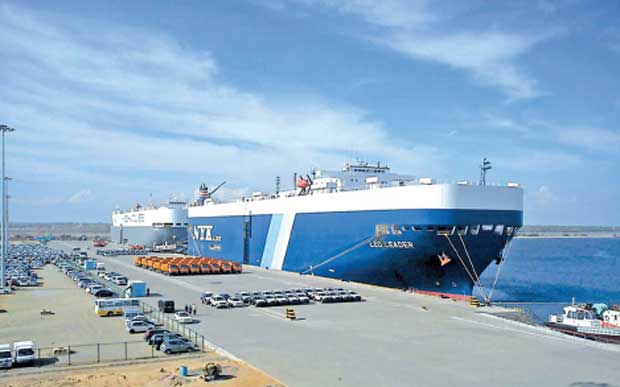19 Sep 2017 - {{hitsCtrl.values.hits}}

BY Asanga Abeyagoonasekera
“The Village in the Jungle’ is different because it’s not about Us, but wholly about Them. It was very advanced in 1913, when many people in Europe were racist.” -Nick Rankin
Rural Hambantota was once best known thanks to featuring in a book by Leonard Woolf in the early 20th century, and now, as a port shaping Sri Lankan politics. Woolf’s ‘The Village in the Jungle’ was the first novel in English literature to be written from an indigenous perspective rather than a coloniser’s.
According to the British author, Nick Rankin, “It was a book about the white chaps at the club who run the show, but about those at the very bottom of the imperial heap, the black and brown fellows who don’t even know they’re part of an Empire, but who just survive day by day, hand to mouth, as slash-and-burn agriculturalists.”
If Woolf was alive today, he would probably be writing his second masterpiece, ‘The Village that was Leased Out’, Hambantota.
After Chinese President Xi Jinping launched the Belt and Road Initiative (BRI), Sri Lanka signed an agreement with China for one of the key strategic projects of this initiative in May 2017. The agreement was to lease out the Hambantota Port with a majority share to a Chinese company for three generations.
The BRI is the “project of the century”, according to Jinping. This trillion-dollar initiative aims to integrate Eurasia through the development of infrastructure. It is unquestionably the most ambitious project ever launched in recent times, which seeks to revisit and resurrect the Ming dynasty’s admiral Zheng He’s global legacy. A century ago, a British geopolitical thinker Sir Halford Mackinder argued that whoever controls the Eurasian heartland will control the world.
The US strategy looks further into Alfred Mahan’s maritime power; after World War II, George Kennan incorporated Mahan’s geostrategic focus on rim lands, rather than heartlands, to his Cold War strategy of containment of the Soviet Union to create a favourable balance of power.
As Washington rebalances to Asia, relations between the US and China have become increasingly contentious and zero-sum oriented. According to Wang Jisi, a Chinese foreign policy scholar, as Washington rebalances towards East Asia, China must avoid a head-on military confrontation with the US. Instead, it should fill in the gaps left by the US retreat from the Middle East. By doing so, China will be able to decisively influence regions free from a US-dominated security order or a pre-existing economic integration mechanism.
The BRI was a construct of Wang Jisi’s initial inputs and strategic thinking, to have a significant Chinese footprint in Eurasia, especially to recalibrate the existing world order. According to the World Economic Forum, by 2030 the US will no longer be the only superpower and China will be well placed among the many countries to become one of the big powers.
Sri Lanka, with its geostrategic position at the centre of the Maritime Silk Road, is a ‘super-connector’ linking the east-west sea lanes. The Sri Lankan people should reap the benefits of the country’s participation in this initiative and it is important that all strategic projects in this regard are carefully calibrated.
However, the process of determining the content of the agreement has not been discussed in parliament, in consultation with think tanks or the public. As a democracy with its sovereignty vested in the people by the constitution, it is important to get inputs from as many quarters as possible when determining strategic projects for the country.
President Maithripala Sirisena pointed out that the debate should go to parliament, an argument which Minister Wijedasa Rajapaksa further expounded and this is absolutely correct. The failure of such public consultations has triggered much internal destabilisation; in the past, the hurried nature of the 13th Amendment to the Constitution – the Indo-Sri Lankan Accord – had triggered the southern insurrection.
China is Sri Lanka’s second largest trading partner, surpassing the US and just behind India. Sino-Lankan trade remains at more than US $ 3 billion. This position will change significantly with the Chinese economic zone and Hambantota port’s full operationality. By 2025, China will become Sri Lanka’s largest trading partner due to the significant investments in the island.
In the geopolitical context, while global hegemon US is strengthening its ties with India, the regional hegemon, other South Asian countries are strengthening ties with China to counterbalance this. India’s role and China’s aspirations in the Indian Ocean remain a topic of debate among scholars. India fears encirclement by China and China feels the same vis-à-vis the US.
Tensions at the lines of intersection are highest at geostrategic hotspots like Sri Lanka. The government’s consideration to lease out the new Chinese-built Mattala Rajapaksa International Airport (MRIA) to India is a measure to counterbalance China. While India, the US and Japan will strengthen the rules-based order of the world, China will be the peace-loving explorer set on transforming the world on a self-proclaimed ‘win-win’ basis.
In this strained geopolitical environment, Sri Lanka should design not a plan based on the process of leasing but rather chart a path within the interests of emergent and existing powers. It must seek to develop a value-added export basket to strengthen its economy.
(The views expressed here are personal and do not reflect those of the Government of Sri Lanka or Institute of National Security Studies Sri Lanka. Asanga Abeyagoonasekera is a visiting lecturer in international political economy (IPE) and Director General of INSSSL, the national security think tank of Sri Lanka. This article was initially published by the IPCS, New Delhi for Dateline Colombo -http://www.ipcs.org/article/india/sri-lanka-leveraging-the-politics-of-geography-a-href-5343.html)
25 Nov 2024 9 minute ago
25 Nov 2024 34 minute ago
25 Nov 2024 1 hours ago
25 Nov 2024 1 hours ago
25 Nov 2024 1 hours ago